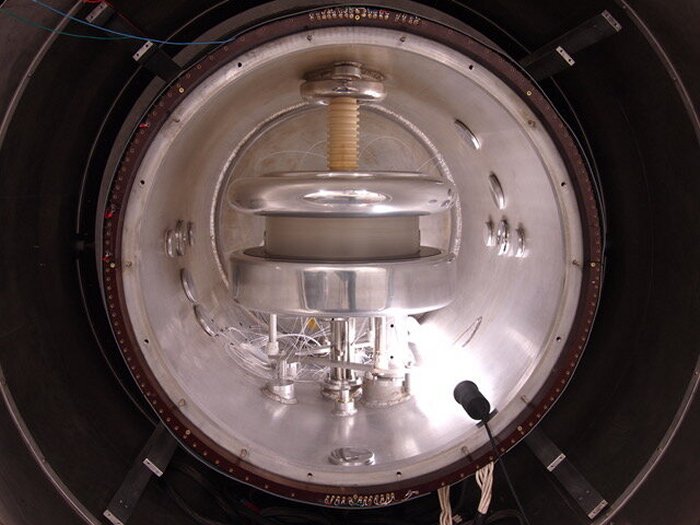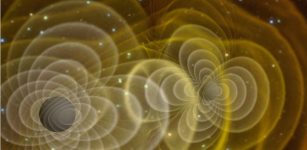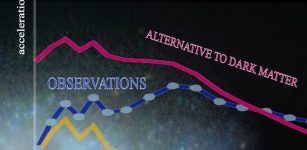Why Is There Any Matter In The Universe At All? – New Study
Eddie Gonzales Jr. – MessageToEagle.com – Scientists at the University of Sussex are measuring a property of the neutron—a fundamental particle in the universe—more precisely than ever before.
To investigate why all the antimatter created in the Big Bang didn’t just cancel out the matter, the researchers have looked into whether or not the neutron acts like an “electric compass.”
 The apparatus for measuring the Neutron’s EDM. Credit: University of Sussex
The apparatus for measuring the Neutron’s EDM. Credit: University of Sussex
Neutrons are believed to be slightly asymmetrical in shape, being slightly positive at one end and slightly negative at the other—a bit like the electrical equivalent of a bar magnet. This is the so-called “electric dipole moment” (EDM).
This is an important piece of the puzzle in the mystery of why matter remains in the Universe because scientific theories about why there is a matter leftover also predict that neutrons have the “electric compass” property. Measuring it then it helps scientists to get closer to the truth about why matter remains.
The team of physicists found that the neutrons have a significantly smaller EDM than predicted by various theories about why matter remains in the universe, and this finding will probably modify the existing theories. The results are reported in the journal Physical Review Letters.
“After more than two decades of work by researchers at the University of Sussex and elsewhere, a final result has emerged from an experiment designed to address one of the most profound problems in cosmology for the last fifty years: namely, the question of why the Universe contains so much more matter than antimatter, and, indeed, why it now contains any matter at all. Why didn’t the antimatter cancel out all the matter? Why is there any matter left? Professor Philip Harris, leader of the EDM group at the University of Sussex, said.
“The answer relates to a structural asymmetry that should appear in fundamental particles like neutrons,” he said.
 Image credit: NASA, ESA, and S. Beckwith (STScI) and the HUDF Team via space.com
Image credit: NASA, ESA, and S. Beckwith (STScI) and the HUDF Team via space.com
“This is what we’ve been looking for. We’ve found that the “electric dipole moment” is smaller than previously believed. This helps us to rule out theories about why there is a matter leftover—because the theories governing the two things are linked.”
The experiment is an upgraded version of apparatus originally designed by researchers at the University of Sussex and the Rutherford Appleton Laboratory (RAL), and which has held the world sensitivity record continuously from 1999 until now.
“The experiment combines various state of the art technologies that all need to perform simultaneously,” Dr. Maurits van der Grinten, from the neutron EDM group at the Rutherford Appleton Laboratory (RAL), said.
“We’re pleased that the equipment, technology, and expertise developed by scientists from RAL has contributed to the work to push the limit on this important parameter.”
Dr. Clark Griffith, Lecturer in Physics from the School of Mathematical and Physical Sciences at the University of Sussex, said:
“This experiment brings together techniques from atomic and low energy nuclear physics, including laser-based optical magnetometry and quantum-spin manipulation. By using these multi-disciplinary tools to measure the properties of the neutron extremely precisely, we are able to probe questions relevant to high-energy particle physics and the fundamental nature of the symmetries underlying the universe. ”
Any electric dipole moment that a neutron may have is tiny, and so is extremely difficult to measure.
Previous measurements by other researchers have borne this out. In particular, the team had to go to great lengths to keep the local magnetic field very constant during their latest measurement. For example, every truck that drove by on the road next to the institute disturbed the magnetic field on a scale that would have been significant for the experiment.
Therefore, the researchers had to compensate for this effect during the measurements.
The measurements ran over a period of two years. So-called ultracold neutrons, that is, neutrons with a comparatively slow speed, were measured.
Every 300 seconds, a bunch of more than 10,000 neutrons was directed to the experiment and examined in detail. The researchers measured a total of 50,000 such bunches.
Written by Eddie Gonzales Jr. – MessageToEagle.com Staff
Related Posts
-
 Rubber That Can Count To Ten – Physicists’ Successful Experiment With Metamaterial
No Comments | Jul 4, 2023
Rubber That Can Count To Ten – Physicists’ Successful Experiment With Metamaterial
No Comments | Jul 4, 2023 -
 Mystery Of Mathematics – The Riemann Conjecture Unveiled By Physics
No Comments | Nov 29, 2021
Mystery Of Mathematics – The Riemann Conjecture Unveiled By Physics
No Comments | Nov 29, 2021 -
 Researchers Teleport Quantum Information Within A Diamond
No Comments | Jun 30, 2019
Researchers Teleport Quantum Information Within A Diamond
No Comments | Jun 30, 2019 -
 New Laser Breakthrough To Help Understanding Of Gravitational Waves
No Comments | May 31, 2022
New Laser Breakthrough To Help Understanding Of Gravitational Waves
No Comments | May 31, 2022 -
 Could Cold Spot In The Sky Be A Bruise From A Collision With A Parallel Universe?
No Comments | Jun 5, 2017
Could Cold Spot In The Sky Be A Bruise From A Collision With A Parallel Universe?
No Comments | Jun 5, 2017 -
 Electron Spin Successfully Measured For The First Time
No Comments | Jun 11, 2023
Electron Spin Successfully Measured For The First Time
No Comments | Jun 11, 2023 -
 Dark Matter Exists: Doubts On Its Presence In Galaxies Have Been Disproved
No Comments | May 8, 2019
Dark Matter Exists: Doubts On Its Presence In Galaxies Have Been Disproved
No Comments | May 8, 2019 -
 One Particle On Two Paths: Quantum Physics Is Right
No Comments | May 15, 2022
One Particle On Two Paths: Quantum Physics Is Right
No Comments | May 15, 2022 -
 Quantum Refrigerator – New Cooling Concept Has Been Invented
No Comments | Aug 3, 2021
Quantum Refrigerator – New Cooling Concept Has Been Invented
No Comments | Aug 3, 2021 -
 When A Band Falls Flat: Searching For Flatness In Materials
No Comments | Apr 1, 2022
When A Band Falls Flat: Searching For Flatness In Materials
No Comments | Apr 1, 2022
